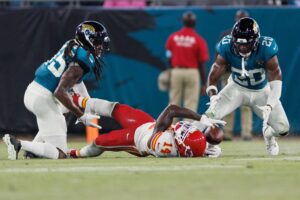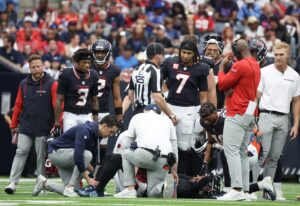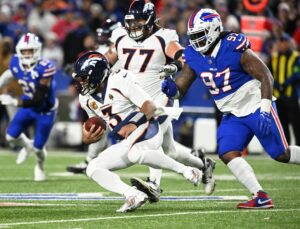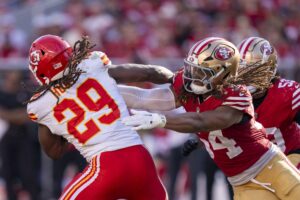The New Orleans Saints, like many other NFL teams, generally preach a “best player available” approach to the draft. However, the Saints have not been afraid to break from this philosophy in recent years.
Last year, New Orleans traded up in the second round to pick center Erik McCoy, then traded up for defensive back C.J. Gardner-Johnson in the fourth round. In 2018, they traded away a first-round pick to move up and select edge defender Marcus Davenport 14th overall.
While these trades have all proven to be good moves so far, the Saints may opt for a less aggressive approach to the 2020 draft.
New Orleans Saints Best Player Available Approach Appropriate for 2020 Draft
Successful Free Agent Haul
First and foremost, New Orleans re-signed quarterback Drew Brees after the 19-year veteran decided to return for another season. However, their 2020 free agent class was headlined by the signing of two-time Pro Bowl wide receiver Emmanuel Sanders. This signing addressed the organization’s only glaring need entering the off-season.
New Orleans also made some tough decisions in the secondary, letting go of cornerback Eli Apple and safety Vonn Bell in favor of re-signing cornerbacks Janoris Jenkins, P.J. Williams, and Patrick Robinson, as well as safety D.J. Swearinger. They also added three-time Pro Bowl safety Malcolm Jenkins and cornerback Deatrick Nichols, a standout during the XFL’s brief existence. While the losses of Apple and Bell are significant, the Saints appear to have improved this position group.
Other significant moves included the re-signing of left guard Andrus Peat and center Cameron Tom, and the addition of fullback Michael Burton, who is the presumed successor for Zach Line. New Orleans also brought back three key members of their special teams unit: cornerback Justin Hardee, long-snapper Zach Wood, and running back Dwayne Washington.
This wasn’t some roster-altering, identity-changing free-agent haul, but that’s not what the team needed. Instead, the Saints addressed needs at wide receiver, offensive line, and fullback while also successfully managing a difficult situation in the secondary. With these items already crossed off of the Saints agenda, they will have tremendous flexibility in the draft.
Less Pressure on Which Position to Address First
The Saints traded up for their first picks the last two drafts because the organization knew it needed a top-notch player at defensive end in 2018, and at center last year. While most fans would probably like to see the Saints add another wide receiver or linebacker when they pick 24th overall, it will be difficult to argue with if they pick a different position.
For instance, let’s say there is a guard that the team grades with a top-15 projection still on the board when the Saints pick. Even though the Saints already re-signed Peat, he’s been the weak-link on the offensive line at times. A rookie guard could sit for a year and eventually steal the starting job. Alternatively, the Saints could draft a successor for right guard Larry Warford, who will be a free agent after the 2020 season.
It also wouldn’t hurt to keep an eye out for an eventual successor for left tackle Terron Armstead. New Orleans has frequently drafted offensive linemen in early rounds under Sean Payton with a high success rate. So no one should be surprised if they take this route even though their line is currently in good shape.
Teams are always looking to improve their defensive line and secondary as well, and New Orleans could look to these positions if the right player falls to them. They will surely be watching the quarterback position as well. Taysom Hill isn’t guaranteed to become the successor to Brees and they need to find a traditional backup for the 2020 season.
All of this is to say that the Saints should (and probably will) focus on which prospect is the best overall player in the first round.
Later Rounds
As it stands now, New Orleans will make four more selections, starting in the third round (88th overall).
If New Orleans doesn’t select a wide receiver with their first pick, they should look to add one at some point. Sanders should make an immediate, positive impact in the Saints offense. However, the players behind All-Pro Michael Thomas and Sanders on the depth chart have not proven to be reliable contributors.
Fortunately, this year’s wide receiver class is projected to be the strongest in years. New Orleans can still strike gold at the position even if they don’t use their first pick on a receiver.
In general, the Saints have a great opportunity to add even more talent at skill positions. A running back selection could be justified by the fact that Alvin Kamara is scheduled to become a free agent after the 2020 season. They could also use a backup with a similar skillset so that New Orleans can keep using plays designed for Kamara if he has to miss time.
Tight end is another position that could be addressed but isn’t necessarily a team need. 2019 free agent signing Jared Cook was a valuable contributor last season, but he will be entering his 12th NFL season. It wouldn’t hurt to start planning for the future at the position and the third spot on the depth chart at tight end is currently wide open.
Further Thoughts
The Saints brain trust must be licking their chops over the possibilities this draft will present. Since the 2017 off-season, New Orleans has tirelessly worked on filling roster holes. The roster is by no means perfect now, but the starting depth chart is virtually locked in with few weaknesses.
This year, New Orleans can let the players fall to them rather than reach for a position of need. This is a great chance to keep an eye out for high-grade prospects that have fallen down the board, passed on by teams that are looking to address a specific position.
On the other hand, packaging picks and trading up would be a lower-risk move this year with so few needs to address. If the Saints feel there’s a once-in-a-generation prospect, they should by all means make a move.
The Saints 2020 draft class will likely be full of surprises and it should be judged mainly by the quality of players picked rather than the positions addressed.
Main Photo:
Embed from Getty Images






